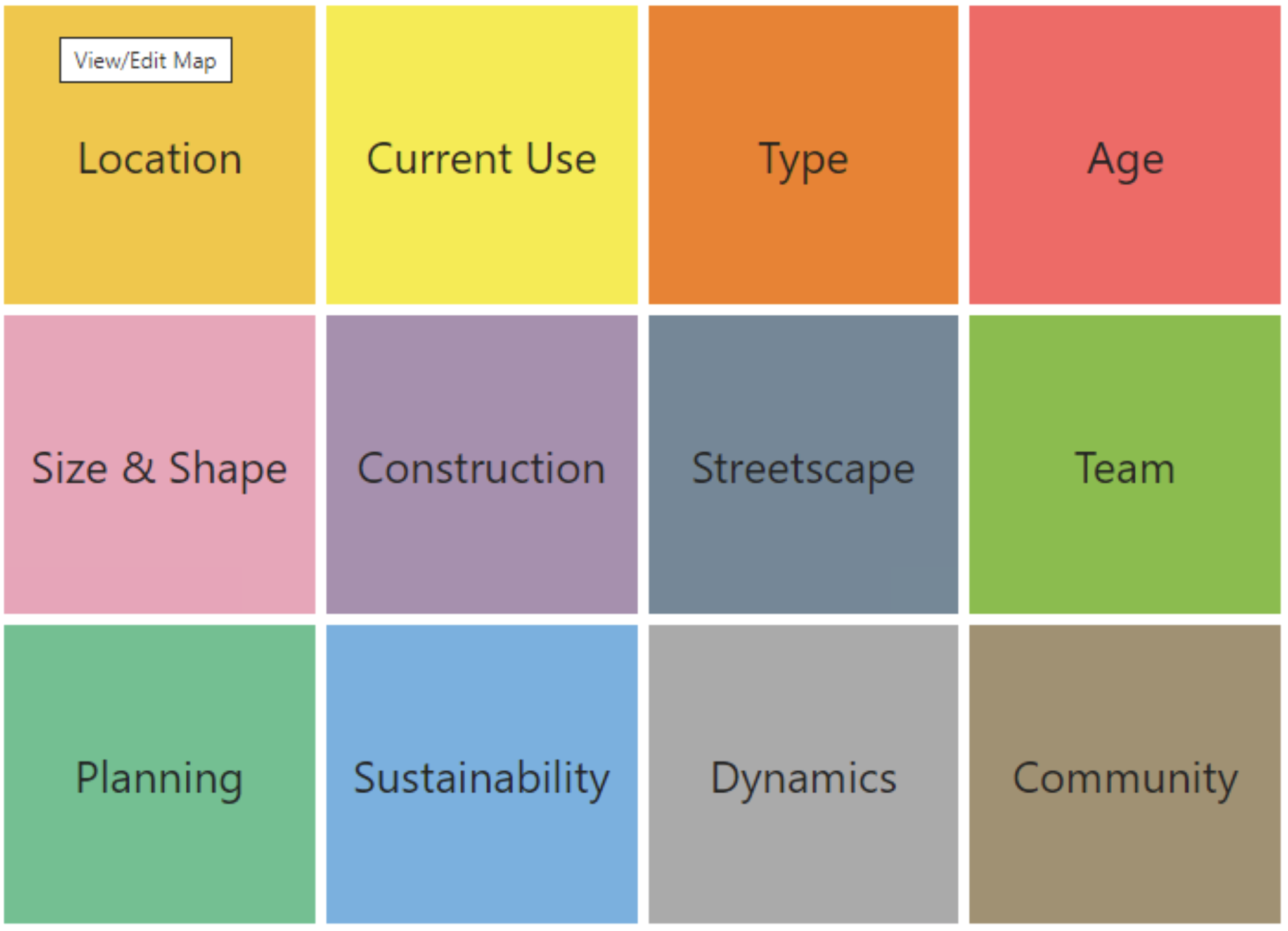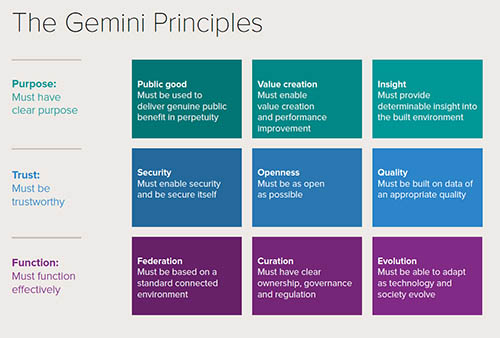
Submitted by Angela Walters on Fri, 15/01/2021 - 09:52
|
Colouring London is described by the ODI as an example of a 'successful collaborative data maintenance model’ along with Wikipedia, Open Streetmap, Music Brainz, and Open Food Facts'. |
The problem:
The building stock is the largest capital asset of a city and its most important socio-economic resource. It is also where the greatest potential for energy reduction in cities lies. Despite this, very few datasets are openly available for UK cities at building and city scale. Indeed, little is known about stock composition at the micro scale with attention still placed mainly on new build (comprising under 1%) rather than existing buildings.
Data are not systematically collected so patterns of demolition and resource and energy wastage cannot be properly monitored. Lack of data also means that scientific analysis on the stock and forecasting of its dynamic behaviour, resilience and sustainability, targeting of retrofit and study of survival, persistence or loss of building types are extremely difficult to undertake.
The aims
Colouring London aims to address this lack of data and to generate new tools for knowledge sharing across sectors, and between actors, including citizens, working in the built environment to accelerate problem solving and to aid delivery of the UN New Urban Agenda. It brings together expertise from science, humanities and the arts to celebrate our cities (and our knowledge about them), collectively, to make them more sustainable.
Development
Colouring London has been supported by grants from the Engineering and Physical Sciences Research Council, Historic England, The Centre for Advanced Spatial Analysis/MacArthur Foundation, UCL Innovation and Business, and Innovate UK/Geospatial Commission, and substantial help in kind from Ordnance Survey and The Alan Turing Institute. More than 50 organisations (local, national and international) have also invested time, advice and/or provided their logos as an endorsement. Voluntary time has also been provided by many individual contributors.
The platform is a model for open databases on urban building stocks, (open code available at github). The database is also specifically designed to provide data to support other building related digital twins, for example 4D procedural models of cities. The platform will also in time generate simulations/visualisations of change to the age of the stock, over more than a century to allow areas vulnerable to short lifespan cycles to be geolocated.
Image: Colouring London - Sustainability
Since 2018, the Colouring London site has had 4.7 million edits, 200,000 of which have been made directly by individual contributors – the remainder have been made by automated processes. Focus to date has however been placed on developing long-term partnerships at local, regional, national and international level. Ways in which automated data generation can be supplemented with expert crowdsourcing data to maximise quality and accuracy are also currently being tested.
There are multiple use cases for the data; collaborations exist with organisations ranging from the Better Archway Forum, the Victorian Society, the Greater London Authority, The Royal Institute of British Architects, The Royal Institute of Chartered Surveyors, The Royal Society of Arts, and the Open Data Institute, to the Ministry for Housing, Community and Local Government (MHCLG), Historic England (our current funder) and UK based and international academics working across a variety of disciplines. A showcase section illustrating applications will be launched this year. Main data categories are shown below.
The measures of success for the project for 2021 include;
-
Completion of data category implementation. Positive feedback on platform and data categories and features and gradual increase of upload and download of data.
-
Reproduction of open platform code in other UK cities and/or of knowledge capture approaches/methods .
-
International expansion and knowledge exchange, building on Colouring Beruit and the University of New South Wales’ planned rollout/testing of Colouring Cities platforms with academic institutions in many Australian cities.
-
Planned presentation of Colouring London at COP26 UN Climate Change Conference, as an example of reproducible open platforms designed to support the UN’s New Urban Agenda goals.
Relationship with the Gemini Principles
Colouring London pre-dates the creation of the Gemini Principles though the team have welcomed them as a valuable tool in describing their work. Colouring London is not a traditional Digital Twin as described by the National Digital Twin programme but it is a digital model of the built environment, integrating a large number of disparate data sets. The way in which Colouring London tests the Gemini Principles may be unique but no less valuable for being so.
- Public Good
Colouring London works to bring together and release comprehensive open data on stocks to enable a whole host of better decisions to be made particularly in relation to housing strategy, and reducing wastage, optimising local area operation, developing resilience and promoting retrofit and reuse.
- Value Creation
The Open Database License (ODbL) allows for open third party use to encourage innovation and use by any sector. The project looks to provide volume open data with the highest accuracy possible.
- Insight
The tool is designed for delivery of insight at a city and street scale. This includes in relation to how the city has behaved in the past and is likely to behave in future.
- Security
Only open data are collected and released. Data ethics are a high priority for the platform and building user privacy is also addressed.
- Openness
This is an open data initiative. Anyone can view, edit and download data. Platform code is also open source and accessible on GitHub
- Quality
Users are asked to feedback on quality through discussion threads. Features including edit history, source, verification button and questions re uncertainty (e.g. earliest and latest possible construction date) are also included to allow users to assess whether the data are suitable for their needs. Methods of improving data quality are also being tested by combining automated methods of data generation with crowdsourced checking, verification, enrichment and additions by specialists.
- Federation
As the service is agglomerated knowledge the tool is not federated but large scale contributors are listed as partners.
- Curation
Data are curated and highly structured owing to the stock’s complexity as a system, the need to make access as easy as possible and to engage a range of technical and non-technical users. Collaborative maintenance of specific datasets is also encouraged - with links provided, where possible, to constantly monitored and updated datasets.
- Evolution
The open tool began as a way of addressing lack of data on stocks and their dynamic behaviour and to find ways to assess survival rates and vulnerability to demolition. It was also designed to capture and combine knowledge, known to be held within local communities, with knowledge held by industry, academia and government at a range of scales.
Based on the Building Exploratory principles, it was also built from the outset to be simple, beautiful and of relevance to multiple audiences, and to be reproducible. More recently the Colouring City data categories have begun to be explored with regard to the provision of context data, and the rapid visual assessment of structural damage, in disaster scenarios.
Conclusions
Colouring London is testing the Gemini principles in the creation of a general-purpose tool which combines “volunteer” contributions with automated processes to increase access to high quality building attribute data for the public good and platform code able to be reproduced free by any city.
Contact:
Polly Hudson, Colouring Cities director. Research Fellow, Alan Turing Institute. Senior Research Fellow Bartlett Centre for Advanced Spatial Analysis, University College London
You can send us comments or ask questions on our discussion threads at https://discuss.colouring.london/.
To view our technical site and platform code please visit Github at: https://github.com/colouring-london/colouring-london.
*Header image extract from Colouring London website, reproduced with permission



